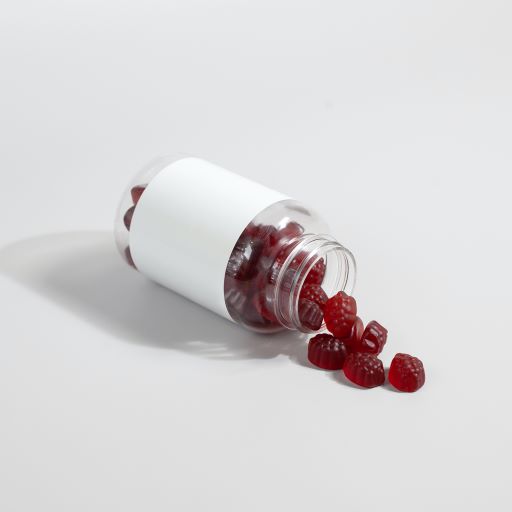“The BEST vitamin for making friends…B-1. Get it!?”
– Anonymous Jokester
What’s the Story
What Are Vitamins?
Vitamins. Everybody has heard the word. We know that we need them and that healthy foods are full of them. But that doesn’t explain a lot about what they do.
According to the National Institutes of Health (NIH) vitamins are things that help our bodies grow and function. Usually they have to be eaten in our diet because our bodies can not make them on their own. For this reason they are called essential vitamins.

There are 13 essential vitamins: A, C, D, E, K, and eight B vitamins.
They are divided into two big categories. Fat-soluble vitamins A, D, E, and K dissolve in fatty substances like oil. Water-soluble vitamins B and C dissolve in water.
What Are B Vitamins?
More than half of all the essential vitamins are B vitamins. They each have a number and a common name. For example vitamin B1 is also called Thiamine. The B vitamins are B1, B2, B3, B5, B6, B7, B9, and B12.
What Does Vitamin B Do?
This group of vitamins has a special importance. They help the body use the energy it has stored and keep our cells and DNA healthy. B vitamins can be eaten in our diet and taken as supplements.
Coming up, we will take a deep dive into this group of vitamins. For each one, we will talk about what happens when we get too much or not enough. Then, go over where they can be found and what they’re used for. Finally we will look at the missing B vitamins and find out why they were taken off the list.
Read on to get energized with a healthy dose of vitamin B!
The B Vitamins
The B Vitamins
For a B vitamin chart with dose recommendations, jump on over to the “Talk Nerdy to Me” section.
This part of the article will focus on the following:
- The vitamin name
- What it’s used for
- What happens with too little or too much
- Supplements and foods high in the vitamin

Vitamin B1 – Thiamine
Thiamine is the first B vitamin for good reason. It helps our bodies make energy from glucose and keep our nerves communicating well.
Not having enough thiamine is pretty rare in Western countries. Thanks to our diets, we usually eat enough B1. People with alcoholism are a known exception. Drinking too much can prevent thiamine from being absorbed properly and lead to life threatening brain damage.
To get a boost of Thiamine, you can take multivitamins, B complex vitamins, or a thiamine-only supplement. However, the best place to get thiamine is through a healthy diet. Get plenty of this nutritious vitamin by eating things like:
- pork
- fish
- grains
- seeds
- nuts
- beans
Vitamin B2 – Riboflavin
Riboflavin is second on our list of B vitamins. It too helps our bodies make usable energy. Also, it is good for our immune system, eyes, and skin. Riboflavin supplements are even used as a way to prevent migraines.
Typically a deficiency – not enough – B2 is pretty rare in people who have a regular diet. Especially since it is added to foods like flour and rice in developed countries. Too much B2 is also uncommon since extra is easily wasted in our urine.
Riboflavin can be taken as multivitamin or B complex supplements. But, it is very easy to get through a good diet. B2 is found in all kinds of foods including:
- meat
- eggs
- dairy products
- grains
- mushrooms
- leafy green veggies
Vitamin B3 – Niacin
So, what is Niacin? Like our first two B vitamins, B3 helps our bodies make energy from the food we eat. It is also good for skin, digestive, and nervous system health. Famously, niacin is known to reduce levels of cholesterol, or fat in the blood.
Not Enough Niacin
Too little niacin is pretty uncommon except in some cases. Exceptions include alcoholism, a poor diet, or disease of the digestive system. Niacin deficiency is called pellagra. This condition can cause the three D’s known as dementia, diarrhea, and dermatitis (skin irritation). What’s more, if untreated this can even lead to death.
Too Much Niacin
Large doses of niacin can cause a well-known side effect called flushing. Folks who experience this may feel hot and have their skin turn red. It can also cause itching and nausea. In addition, too much niacin may cause liver damage.
Niacin can be found in multivitamins, and supplements. Unlike other B vitamins, it is also available as a prescription to treat high cholesterol. It can be heated and cooked because it is very stable. That’s great news since it is in a wide variety of foods like nuts, grains, and mushrooms. You can also find a lot in foods with protein like:
- beef
- fish
- poultry (chicken, turkey)
- pork
Vitamin B5 – Pantothenic Acid
Pantothenic acid, like other B vitamins, helps the body break down nutrients for energy. In addition, it is used to make new blood cells and hormones.
Some B5 can be found in a wide variety of foods and vitamin supplements. This means deficiency is very unlikely. However, joint pain is a common complaint for people who need more B5 in their lives.
Foods rich in pantothenic acid include:
From Animals
- meat
- dairy
- eggs
From Plants
- peanuts
- sweet potatoes
- beans
Vitamin B6 – Pyridoxine
Pyridoxine is another common B vitamin which is used to help our bodies make energy and red blood cells. In addition, B6 supports hormone and immune function. It also helps with brain function and the production of brain chemicals. Pyridoxine alone or combined with doxylamine is used to treat nausea and vomiting for pregnant women. This is often referred to as morning sickness.
B6 deficiency is rare outside of certain groups of people such as: those with alcoholism, thyroid disorders, women who use birth control pills, and the elderly. Too much pyridoxine is usually due to taking too much from supplements. This can lead to nerve damage.
Pyridoxine can be found in multivitamins and supplements. But like the other vitamins, it is best eaten through diet. Some sources of B6 include:
- grains
- beans
- leafy veggies
- fruits
Protein sources are also full of B6 including:
- meat
- fish
- poultry (chicken, turkey, etc)
- nuts
Vitamin B7 – Biotin
The B vitamin biotin does good work keeping our hair, skin, and nails healthy. Biotin also helps our bodies make energy from things like fats, proteins, and sugars.
Low levels of B7 are very uncommon since it can be found in common food sources. Known exceptions are in people who over-eat egg whites. This is because the whites, also called albumen, can prevent biotin from being absorbed. Too much biotin can cause high cholesterol levels.
Other than multivitamins and B supplements, biotin can be found in the diet too. Some good sources of B7 are:
- chicken
- organs (like liver)
- egg yolk
- peanuts
- cauliflower
- mushrooms
Vitamin B9 – Folate (Folic Acid)
Folic acid is an incredibly important B vitamin. It’s famous for its use as a prenatal vitamin for pregnant women. This essential vitamin makes sure that a baby develops properly. In our bodies folate also helps make red blood cells.
A folic acid deficiency in pregnant women can hurt the development of a fetus. It can lead to a condition called spina bifida. This is a defect that harms the baby’s nervous system and causes birth defects. Too much folic acid can be toxic. It can make people feel generally ill and have an upset stomach.
What is folate?
Folate is the natural form of B9. It can be found in many healthy folate foods such as:
- leafy green veggies
- asparagus
- beans
- seeds
- grains
- citrus fruits
It can also be found in animal products like liver, chicken, and eggs.
Folic acid is the man-made version that is used in B9 supplements and can be added to foods. This process is known as fortification.
Vitamin B12 – Cobalamin
The famous B12 vitamin is good for many things. Cobalamin helps protect nerve cells and our ability to think clearly. Additionally, it has important functions producing energy by helping form red blood cells and break down what we need to give our bodies energy.
Too little cobalamin causes fatigue and low energy. Elderly folks can be at risk for low levels since the ability to absorb this vitamin decreases with age. Some medications can also lower B12 levels and add to this risk. Be sure to ask your pharmacist or healthcare provider if you are concerned about any of your medications interacting. Sickness from too much B12 is unlikely.
Interestingly, B12 can only be found in the diet through animal-made proteins. So, foods high in B12 include:
- meat
- fish
- dairy
- eggs
People who follow a vegan diet do not usually eat B12 foods. These folks need to use supplements to ensure they get enough cobalamin.
Vitamins B12 and B9 work side by side so it’s important to get plenty of both. It is not good to have one and not the other.
Final Thoughts
The B complex vitamins are incredibly important to our everyday lives. They help our bodies make energy, use energy, recover from injury, and improve the function of our organs and cells. Although, the truth is that taking more B vitamins than you need will not improve your health. However, if you’re feeling run-down and there’s no other cause, adding some B vitamins to your lifestyle might perk you up. Getting your vitamins through a good diet is best, but the essential B’s are also available as supplements.
Still feeling curious? The next section talks about why there’s no Vitamin B4. And for more information on the antioxidant vitamins A, C, and E, check out this article.
Lost B Vitamins
The Forgotten B Vitamins
At the turn of the 20th century, the vitamins were discovered. At that time, scientists thought that all the B vitamins were the same chemical but had multiple jobs in the body. While it is true that many vitamins have similar functions, we now know that the B vitamins are made up of multiple different chemicals. So the science community split up the newly discovered chemicals into the B vitamin system we use today.
Why Some Were Removed

As you can see, vitamin B4, B8, B10, and B11 are not included in our list. Why? There are a few answers.
Some early vitamins were named before we understood their chemical structure. It turns out, they are minerals not vitamins.
Still, other early B vitamins were later considered non-essential. Meaning, our bodies can make them without eating them.
Lastly, some of the original vitamins were found out to be mixtures of several vitamins.
What About the Other Numbers?
At this point, you probably have the same questions I did. Where are the missing B vitamins and what were they?
Vitamin B4
B4 has been used to represent many different molecules over the years. Some of these names include choline and adenine. Others sources believe B4 referred to a mixture of arginine, glycine, and other known B vitamins.
In any case, none of these can truly be considered a new vitamin. So, B4 has been left out.
Vitamin B8
B8 has gone by the names inositol and adenylic acid. In the end, neither of these chemicals were vitamins, so vitamin B8 was abandoned as well.
Vitamin B10
B10 is more commonly known as PABA. This is short for (para) 4-aminobenzoic acid. Quite a mouthful!
Although this molecule is an important one, it is not a true vitamin. It does help make some of the true B vitamins however. And some sources believe that B10 is a mix of other B vitamins.
Vitamin B11
A version of folic acid is commonly referred to as vitamin B11. However, it has also gone by other names. Some sources claim that it is known as salicylic acid. Still, others say that the effects of B11 were due to a mixture of other B vitamins.
In the end, the vitamin B11 is no longer used.
Talk Nerdy to Me (Details for Professionals and Curious Minds)
B Vitamin Daily Intake
| Vitamin | Men | Women | Pregnant Women |
| B1 | 1.2 mg | 1.1 mg | 1.4 mg |
| B2 | 1.3 mg | 1.1 mg | 1.4 mg |
| B3 | 16 mg | 14 mg | 18 mg |
| B5 | 5mg | 5 mg | 6 mg |
| B6 | 1 – 1.7 mg | 1 – 1.7 mg | 1.9 mg |
| B7 | 30 mcg | 30 mcg | 30 mcg |
| B9 | 400 mcg | 400 mcg | 600 mcg |
| B12 | 2.4 mcg | 2.4 mcg | 2.6 mcg |
The B complex of vitamins behave as coenzymes which catalyze both catabolic and anabolic functions in the body. As water-soluble compounds they are readily eliminated in urine.
B1 – Thiamine
Absorbed in the duodenum, Thiamine is converted to its active form, thiamine pyrophosphate (TPP) with the use of magnesium. TPP is used in the citric acid cycle (formerly Krebs cycle), making it an critical component in cellular respiration. TPP is also involved in the production of acetylcholine and gamma-aminobutyric acid (GABA). As a precursor, it is indirectly involved in glutamate production as well.
A deficiency of clinical significance can result in Wernicke-Korsakoff syndrome. This syndrome is further stratified into Wernicke encephalopathy and Korsakoff psychosis. Both are known to impact people who suffer from alcoholism, are progressive, and should be managed with treatment doses of intravenous thiamine for 5 days.
B2 – Riboflavin
Riboflavin also appears to exert antioxidant activity throughout various cellular processes including cellular respiration and immune system function.
Deficiency remains of concern in people with liver disease, alcoholism, or a need for hemodialysis. Interestingly anticonvulsant, anticholinergics, and phenothiazines can decrease B2 absorption and also promulgate deficiency. This can manifest as metabolic disorders resulting in fatigue, anemia, and hair loss.
B3 – Niacin
Metabolized from tryptophan, niacin is the precursor for nicotinamide. This functional molecule is the preferred formulation for treatment of deficiency. It is utilized in DNA repair mechanisms as well as for cholesterol synthesis.
Although Niacin lowers cholesterol levels, studies have failed to demonstrate a cardiovascular benefit or mortality risk reduction. Toxicity from B3 is known to occur at commercial doses above 3g/day.
B5 – Pantothenic Acid
Pantothenic acid is essential in the production of life sustaining compounds such as cholesterol and acetylcholine. Some available clinical evidence suggests B5 supports wound healing and maintenance of healthy cholesterol levels. Although information is scant.
There is limited data regarding toxicity and deficiency is rare in developed countries due to diet and fortification.
B6 – Pyridoxine
Pyridoxine function supports normal levels of homocysteine, a ubiquitous precursor compound. It has a large role in the synthesis of neurotransmitters serotonin and dopamine and may have an adjunct role in the treatment of migraines, depression, and other mood disorders. It functions as an antidote for several chemicals including isoniazid and ethylene glycol.
Deficiency is rare in isolation. However, medications such as isoniazid, hydralazine, and levodopa can complicate pyridoxine metabolism. People with mild deficiency may be asymptomatic. Although, more acute cases result in microcytic anemia, dermatitis, EEG changes and cognitive decline. Peripheral neuropathy can be the result of toxicity.
B7 – Biotin
Biotin is involved in cellular signaling and replication. There are many purported uses of biotin, especially concerning cosmetics, however clinical data to substantiate these claims remain insufficient.
Although deficiency is generally rare, decreased concentrations have been observed in people taking common antiepileptics such as carbamazepine, phenytoin, and phenobarbital. Excess biotin intake is not generally associated with toxicity.
B9 – Folate (Folic Acid)
In addition to its roles in hematopoiesis, folic acid also aids in nucleic acid synthesis. As a therapeutic, folic acid is used as a supplement in the setting of megaloblastic anemia.
Folate deficiency is typically a complication of poor diet and malabsorptive disorders. Supplementation is required in the setting of methotrexate use. Anti-seizure medications can impair folate absorption as well as errant genetic polymorphisms. Toxicity is exhibited with doses exceeding 1 g/day over an extended timeframe.
B12 – Cobalamin
Gastric acid begins the digestion of animal proteins releasing cobalamin which is absorbed in the distal ileum. B12 is an important cofactor in DNA, hormone, protein, and lipid synthesis.
Common medications associated with low B12 concentrations include proton pump inhibitors (PPIs) and metformin. Replacement of cobalamin depends on the etiology of deficiency. For example, a person who has a malabsorptive process will require parenteral supplementation. Conversely, a person with a dietary deficiency is replete with oral supplementation.
Thank you for reading through this extensive but not exhaustive summary. For any additional information feel free to contact us.
References
- National Center for Complementary and Integrative Health. Vitamins and Minerals. NCCIH. Published February 2018. https://www.nccih.nih.gov/health/vitamins-and-minerals
- Services D of H & H. Vitamin B. Better Health Channel. Published August 2022. https://www.betterhealth.vic.gov.au/health/healthyliving/vitamin-b
- Hanna M, Jaqua E, Nguyen V, Clay J. B Vitamins: Functions and Uses in Medicine. Perm J. 2022;26(2):89-97. doi:10.7812/TPP/21.204
- Williams, PG. The missing vitamin alphabet. Nutrition and Dietetics, 2016;73 (2), 205-214. doi:10.1111/1747-0080.12212
- Whelan WJ. Vitamin B4. IUBMB Life. 2005;57(2):125. doi:10.1080/15216540500078939
- Drozd KV, Arkhipov SG, Boldyreva EV, Perlovich GL. Crystal structure of a 1:1 salt of 4-amino-benzoic acid (vitamin B10) with pyrazinoic acid. Acta Crystallogr E Crystallogr Commun. 2018;74(Pt 12):1923-1927. Published 2018 Nov 30. doi:10.1107/S2056989018016663
- Getoff N. Vitamin free radicals and their anticancer action. Review. In Vivo. 2009;23(4):599-611.
- The B Vitamins | Filling in the Gaps! Oxford Vitality. Published October 2016. https://oxfordvitality.co.uk/blogs/news/b-vitamins-filling-the-gaps


Pingback: How to Fill Your Diet with Antioxidant Vitamins - Pharm @ Table
Very interesting. I always think nowadays, with processed food and fruit/vegatables travelling so far, the nutrionial aspects of our food may not be as strong like a farm to table chain. Because of this I use vitamins supplements. Great article!
It’s true, so hard these days to get complete vitamin coverage. I’m glad you found the article helpful! Thanks for taking the time to reach out.